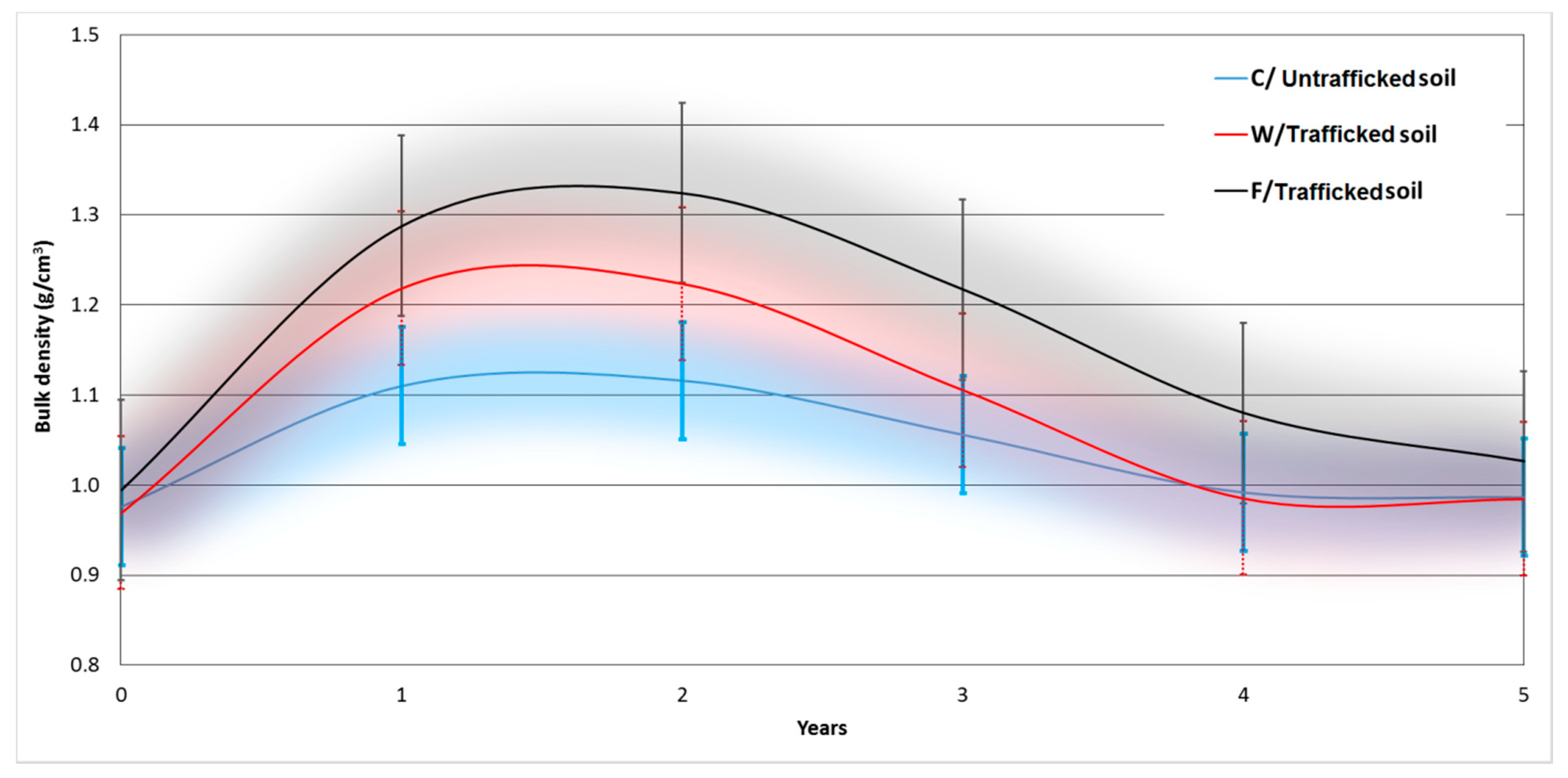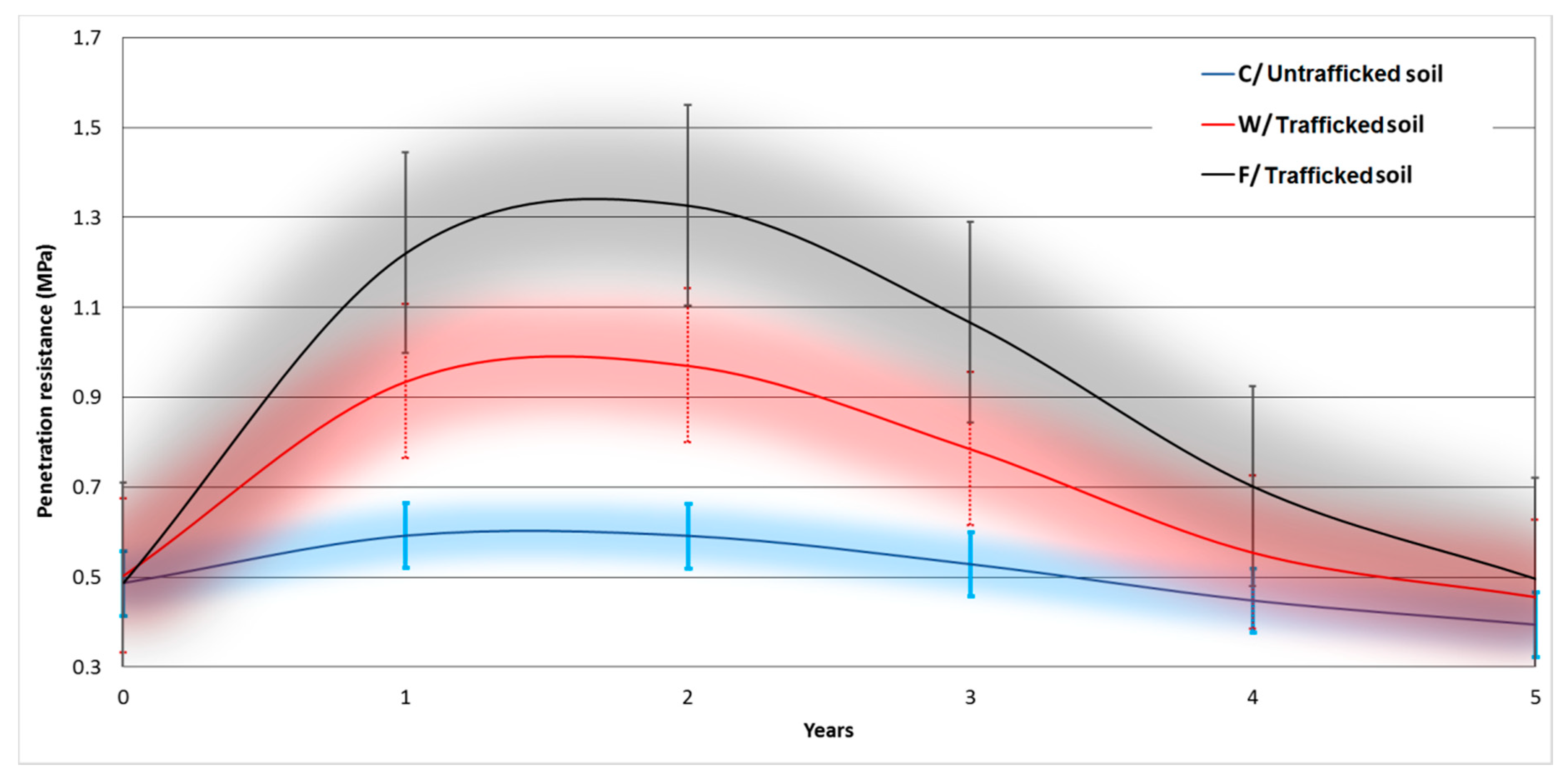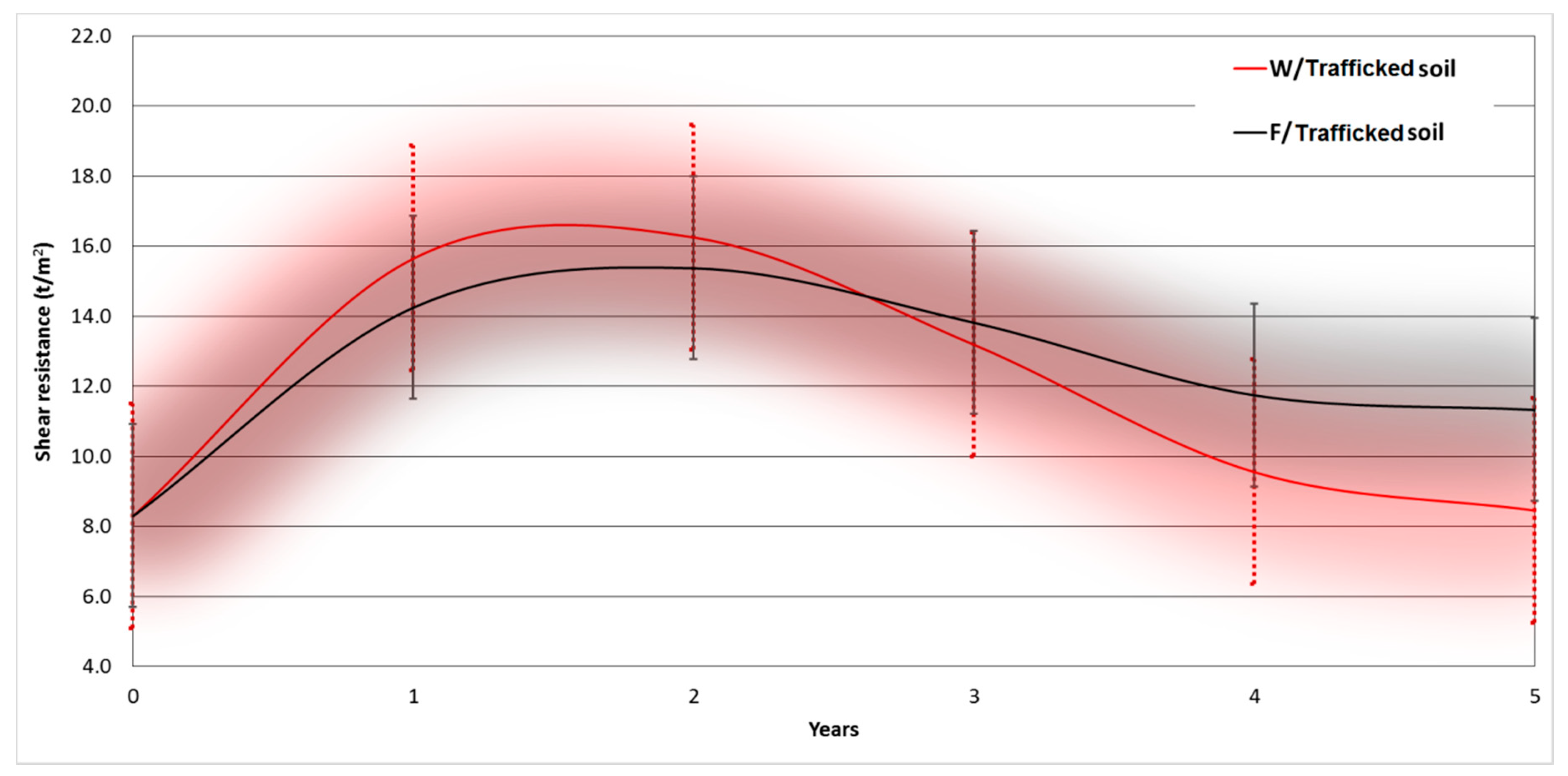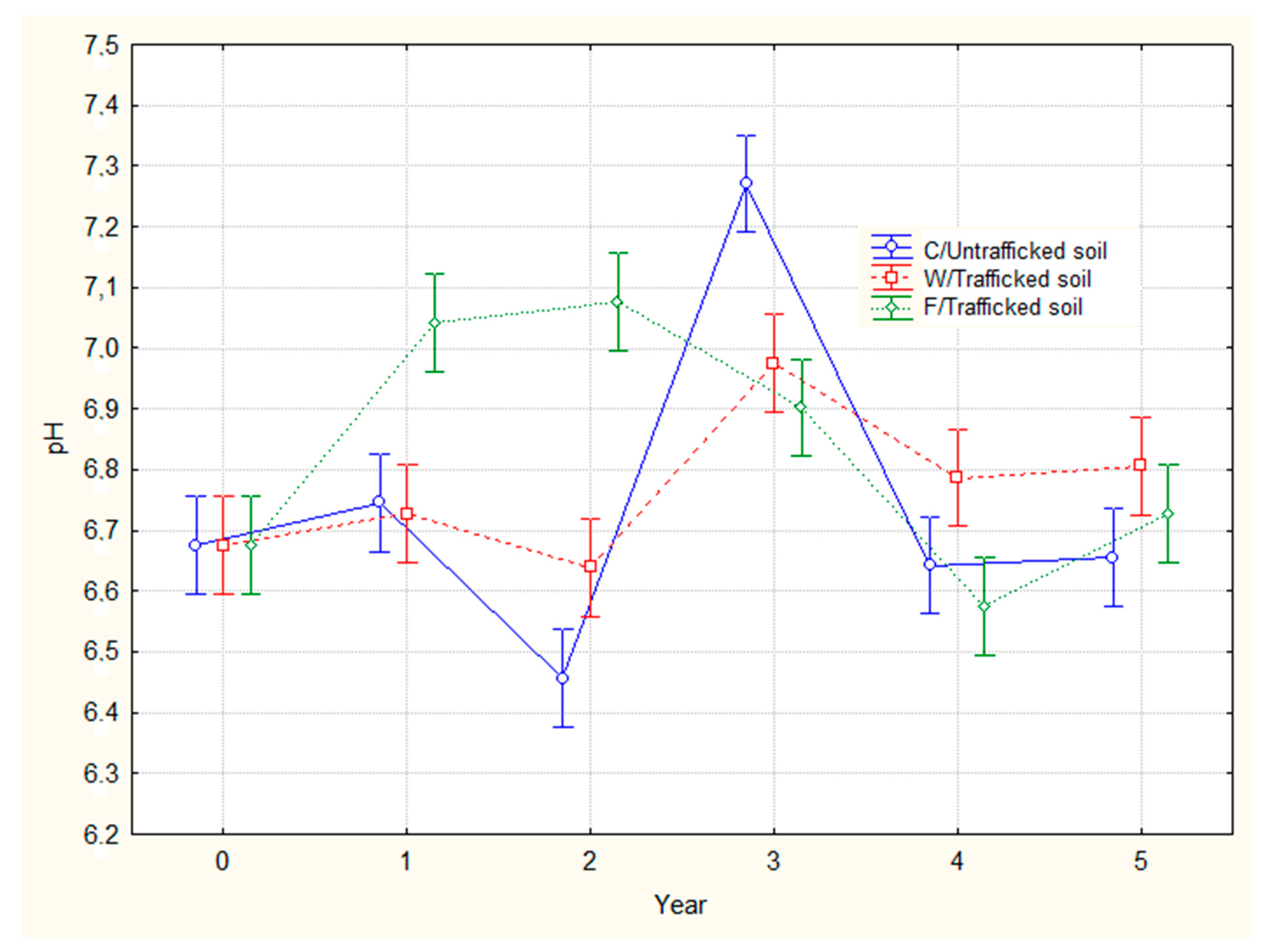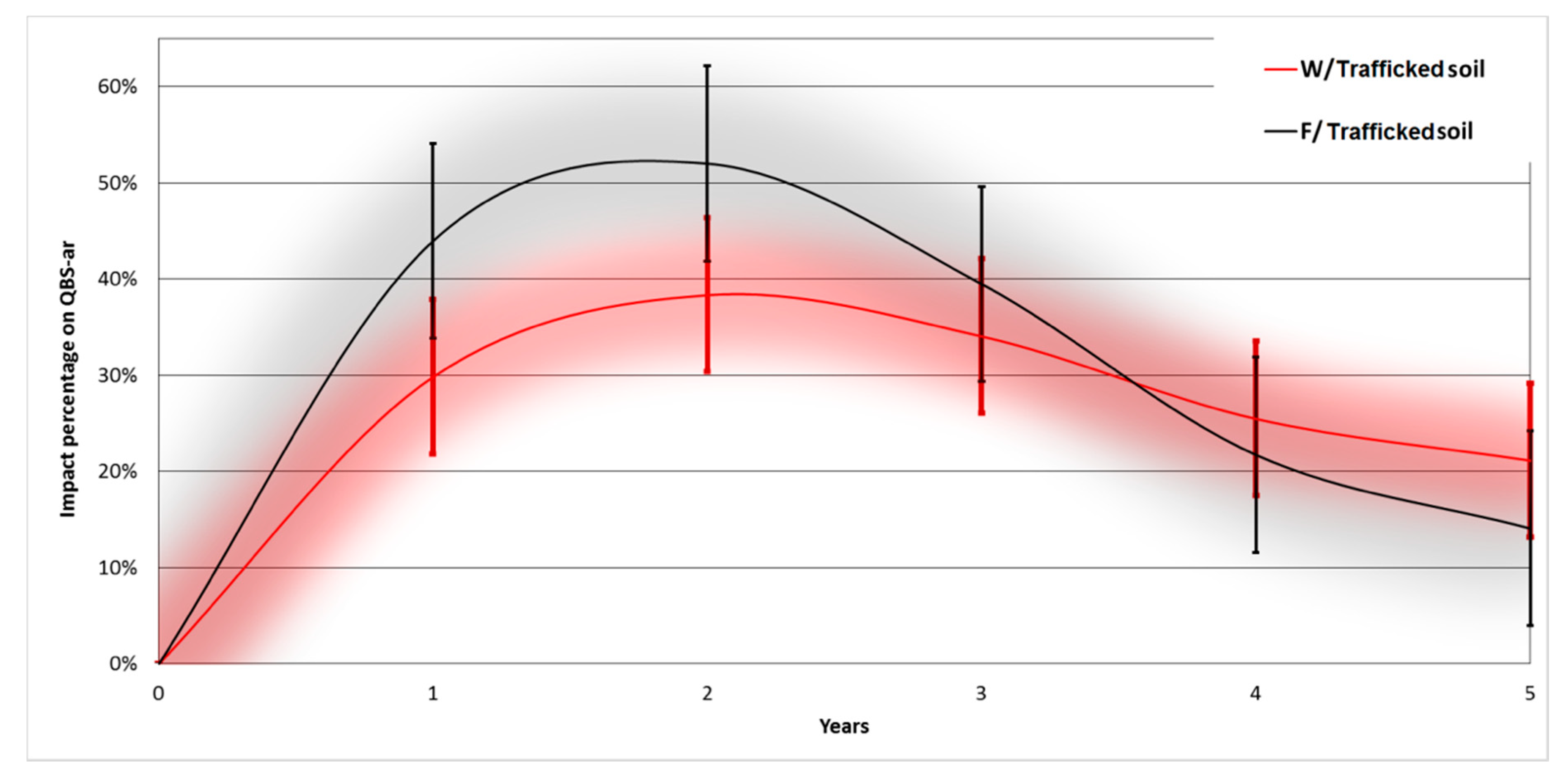1. Introduction
The coppice management system is one of the most debated topics in the Mediterranean area, as it is a forest management system that accounts for over 23 million hectares [
1]. Coppicing is considered the oldest form of sustainable forest management and for this reason it is considered as a natural forest management system [
2]. Its past and current popularity is mainly due to its capacity to positively contribute to the rural economy and ecosystem services [
3]. Even if this management system presents environmental shortcomings, coppicing represents a valid and flexible management system that requires low inputs and guarantees maintenance of many aesthetic, environmental, social, and economic functions [
1,
4,
5].
Recent findings in ecological and forestry research have highlighted that coppice forests contribute to soil protection and biodiversity conservation [
6,
7], showing good resilience and significant adaptability to climate change [
1,
8].
In the past, Mediterranean oak coppice stands were an important source of timber, firewood, and charcoal [
9], as well as litter and pasture [
10]. Today, they are mostly invested in the production of wood biomass for energy use due to their capacity to yield sustained amount of raw material at short intervals (on average one cutting cycle is every 12–18 years) [
2].
These short cutting cycles could negatively affect soil quality and regeneration vigor [
11,
12]. Special concern is aroused by the risk for soil degradation connected with frequent machine traffic, which may cause compaction, topsoil removal, and general disturbance [
13,
14,
15,
16]. Nevertheless, not all logging techniques have the same impact potential and the specific characteristics of any given operation depend on site characteristics, silvicultural management, technological level, and product strategy [
17,
18]. Furthermore, technological innovations in forest logging and mechanization [
19,
20] could positively contribute to the improvement of work conditions, compared with traditional logging systems [
21,
22].
Assessing ground disturbance and minimizing possible damage due to silvicultural treatments and forest operations remain the main focus of sustainable forest management (SFM) [
23,
24,
25]. In order to reach this aim, numerous suggestions have come from recent research, namely: to minimize the area of soil disturbance and compaction by appropriate operation planning [
18,
26,
27]; to make careful execution of logging operations [
28,
29]; and to use suitable mechanization [
12,
30,
31,
32,
33,
34]. All this is in consideration of the fact that adequately managed forest ecosystems are highly resilient in the long-term [
25,
35].
Focusing the attention on coppice systems, there is a need to acquire more information about the impacts due to silvicultural treatment, i.e., actual logging and their interactions. These topics are very often the subject of heated arguments and detailed scientific results are needed to better understand the issue and provide best practice suggestions [
2]. For these reasons, the concept of sustainability is frequently overlooked and is not considered as a clear instrument to assess the impact of global change and development.
SFM is based on continuous improvements of silvicultural practice and logging methods. In particular, better knowledge is needed on the recovery time of managed forest ecosystems after the inevitable disturbance cause by forest operations, however well they are managed. This is one of the key factors for sustainable use and an important issue both for high forests and coppices [
1].
Recent studies [
4,
5,
36] on coppicing in the Mediterranean area have highlighted that within a short time after harvesting (0–3 years), soil and regeneration characteristics show clear signs of recovery. These findings demonstrated that physical, chemical, and biological soil features were only marginally affected by the silvicultural treatment applied, but strongly impacted by harvesting operations.
Coppicing maintains a cyclical pattern of extreme changes in ground-level light penetration [
1,
37,
38], producing heterogeneous mosaics of forest in various stages of succession that harbor a rich variety of animals and vascular plants [
39,
40,
41,
42,
43].
Only efficient planning and management of forest operations and accurate knowledge of the environmental dynamics of the forest will offer high social and environmental benefits and provide various ecosystem services in the long term [
44]. These aspects can be guaranteed only through SFM in synergy with sustainable forest operations (SFO) [
45]. These tools are essential for proper environmental protection and they are mandatory in order to maintain forests and their multiple functions [
45]. In particular, forest operations and coppice management are interesting but delicate issues to be analyzed and evaluated in order to achieve real sustainability.
Starting from this background to increase scientific knowledge on the effects of coppicing, the present experiment was designed with four specific goals:
to investigate the impact of the silvicultural treatment on soil condition;
to find out how both silvicultural treatment and forest operations influence soil characteristics;
to compare the impact of two different harvesting techniques on soil condition;
to assess the recovery capacity of soil after harvesting in order to project a possible treatment return time; and evaluating the existence of a proper SFO.
To this end, soil conditions in a Turkey oak coppice located in central Italy were monitored every year for five years after harvesting.
4. Discussion
First of all, it is important to state upfront the possible limitations of this study so that any conclusions are interpreted with due caution, especially when it comes to generalization. Even if the analyses were done with statistical normalization and standardized methodologies, some residual limitations are still present. The main possible limitation is the reference to one specific stand and machine system. This is a common limitation of most studies of this type and while the stand was representative of a wider typology, it is clear that different results could have been obtained on different stands or on the same stand type growing on a different soil substrate. The same goes with machine selection, since both winching and forwarding can be applied with a wide range of different machines with different competence and with different levels of attention to minimizing undesirable environmental effects. Nevertheless, this study offers an interesting example of how different extraction techniques can impact the physical and biological characteristics of forest soils, and it is still suitable as an approximate general reference until more data will be available for other forest and machine types.
Comparison with previous studies supports cautions generalization. The proportion of the trafficked surface is only slightly higher than reported by Marchi et al. [
4] and very close to that reported by Venanzi et al. [
5], Picchio et al. [
53], and Jourgholami et al. [
54]. In fact, the highest value reported in the study for forwarding—31%—matches almost perfectly the 33% benchmark offered by Spinelli et al. [
55] for the harvesting of coppice stands with traditional ground-based technology in Central Italy. In that regard, one must be aware that the proportion of total surface disturbed by forest operations is widely variable and is strongly dependent on the type of intervention, with the lightest harvesting operations—such as the selective removal of individual trees—impacting as little as 5% of the total surface [
56] and the heaviest ones—the salvage of large windthrown areas—affecting over 50% of the total surface [
57], and that independently of the harvesting technique. As a matter of fact, this study also highlights the role of silviculture, indicating that significant soil impacts occur even in the absence of machine traffic, by merely removing the forest canopy, which can be easily construed as the most traumatic event for the forest ecosystem.
Corroboration for the results of this study is also offered by previous studies of soil compaction consequent to harvesting. The 14% to 19% soil bulk density increase recorded here matches quite well the 12% increase recorded in Mediterranean pine forests by Kleibl et al. [
58]. This value is twice as large as recorded by Magagnotti et al. [
59] for dedicated forest skidders (increase in soil BD ca. 6%), but one must account for the different technology and for the very good floatation capacity of the dedicated forest equipment used in the quoted study. In any case, the post-impact soil BD values recorded in these studies and those obtained from the current experiment are almost the same, and range between 1.1 and 1.3 g cm
−3. This is very important because several studies indicate that root growth is impaired only when soil BD reaches higher values than here, and in the range of 1.7 to 1.8 g cm
−3 [
60,
61]. Therefore, it is unlikely that the level of compaction recorded in this study may stunt stand growth, which is also confirmed by the fact that the soil started recovering relatively quickly, and in most cases the original soil properties were fully restored within five years. Incidentally, this result is even better than reported by Kleibl et al. [
58] for Mediterranean pine stands also located in Central Italy, where full recovery was not achieved within the sixth year.
The study also showed that winching caused lighter soil disturbance compared with forwarding, and generally allowed for faster recovery, except in the case of QBS-ar. However, this is a contentious subject because the studies that have compared the soil impacts caused by tree-length and cut-to-length harvesting offer contrasting results: some support the findings of this research and indicate that TL causes lighter impacts [
2], while others support the exact contrary [
62,
63]. The issue is likely one of machine selection and operational planning. In particular, one may argue that the forwarder used in this study may have been too big for the work at hand, and that the higher level of disturbance it caused could have been avoided if one had selected a lighter machine, like one of the many mini-forwarder available on the market and used in Italy, too [
64]. In any case, the problem is that winching is a labor-intensive work technique with a much lower technical and financial performance compared with forwarding [
65]. What is more, winching is a very tiresome job and none of the solution adopted to relieve operator’s fatigue has been fully successful [
66,
67]. As a matter of fact, this work technique has almost disappeared from the coppice operations conducted in more industrialized countries like France [
31,
68]. Italian loggers are now looking with increasing interest to modern forwarder technology [
69]. Finally, a decisive step towards mechanization is the best way to reduce fatalities in forest operations, which should be a strategic objective and a strong ethical obligation [
70].
In decreasing order of disturbance, soil SR, QBS-ar index, OM content, and BD were influenced by coppicing.
Full recovery was observed between the fourth and fifth year for OM content and BD. Instead, soil PR and pH were not influenced at all by coppicing. This was shown by the comparison of untrafficked soil surfaces in the coppiced areas with the control areas (left unmanaged for the last two decades). These findings are marginally similar to what was found by Venanzi et al. [
2,
3,
4,
5] and Marchi et al. [
4]). These soil parameters could be affected by weather events, but due to the quick canopy regeneration in coppice management these impacts were limited to a period of few years after harvesting (3–5 years).
As found also by many authors [
2,
4,
5,
28,
29,
32,
48,
71,
72], in the short-term, the soil disturbance caused by forest operations showed significant differences between trafficked and untrafficked soil samples. In this case the highest impact being found for forwarding rather than winching, especially in the first year after harvest. However, a recovery trend clear emerged within the second or third year, depending on specific soil property and treatment.
Five years after logging, the two harvesting techniques showed different recovery trends. For the areas extracted by winching, BD and PR showed a complete recovery, while SR, OM, and QBS-ar index showed an important but incomplete recovery with percentages of residual impact varying between 24% and 44%. Conversely, in the areas extracted by forwarding, BD, PR, SR, OM, and QBS-ar index showed an important but incomplete recovery with residual impact varying between 4% and 144%. Consequently, as also suggested by Venanzi et al. [
2], there is a need to discuss a possible limit on forest soil surface directly affected by the moving of machinery and logs, even if recovery could be considered relatively fast. The better results shown by winching was related to the limited movements of the tractor directly on the forest floor, since the tractor stationed on the road.
Differently from what was found by Venanzi et al. [
2], soil organic matter content was not clearly influenced by coppicing and complete recovery was possible four years after logging. In general, the chemical and physical parameters observed were similar to those found in other studies [
2,
4,
5] but in this forest typology the recovery of the soil disturbance specifically caused by coppicing (canopy removal) was recovered 3–4 years after harvesting.
As found also by Venanzi et al. [
2], logging activities showed significant modification of OM content for both harvesting techniques. Recovery started 2–3 years after logging and it was expected to be complete after 7–8 years. The negative variation in OM content during the first years after coppicing may be linked to canopy removal, which means a lack of leaves contributing to litter formation and an increase in the respiratory activity of soil microorganisms. Quick recovery shown was linked to fast canopy regeneration and to the release of the twigs on the ground, both typical of coppice management.
Soil pH did not show any clear statistical relation with treatments or time. As found in other studies [
2,
4,
5,
12,
71], soil pH generally shows low variation and is not clearly connected with soil disturbance.
As also showed in other research [
2,
4,
5] QBS-ar index was negatively influenced by coppicing, and recovery was slower here than showed in other studies (expected 6–7 years after logging). That was consistent with the physical and chemical properties of the observed soil. This was shown by a comparison of the untrafficked soil surfaces in the coppiced areas with the control areas.
The QBS-ar index is often linked to physical and chemical soil parameters, therefore it is logical that significant differences in the QBS-ar index would be found between trafficked and untrafficked soil samples. The greatest impact was for winching areas (48%) and the lowest for forwarding areas (40%). Similar values were found in other similar studies [
2,
4,
5,
28,
29,
48]. Soil recovery was evident three years after coppicing and it showed different rates for the two harvesting techniques. Five years after harvesting, the forwarding areas showed an important recovery with only 4% residual impact, while the winching areas showed a modest recovery with still 40% residual impact. This result, in contrast to the other soil parameters, is closely linked to the different working capacities of the two machines used, which has resulted in the forwarder completing the harvesting in a much shorter time. Therefore, the disturbance inflicted on soil micro-arthropods lasted a much shorter time compared with the disturbance inflicted by the tractor with winch.
Although these findings underline the vulnerability of forest soil due to natural and/or human disturbance [
73], in the case of coppice management the forest soil showed a significant recovery in a short period, highlighting that this silvicultural practice is sustainable and that coppice stands are quite resilient in the face of external disturbance.
Within such context, precision forestry could be an interesting approach to reduce impacts, through rationalized planning of logging operations [
74]. The design and application of low impact logging methods [
18,
19,
20,
21,
22,
23,
24,
25,
26,
27] and sustainable forest operations (SFO) criteria, together with operator training is the mainstay of reduced impact logging, rather than the mechanization level.
Principal non-metric multidimensional scaling (NMDS) tests produced a two-dimensional ranking (
Figure 7) that provided a significantly greater reduction in statistical stress than expected by chance (α = 0.05). When considering BD, PR, SR, OM, pH, and QBS-ar index, the two axes explained 96.2% of the overall variance. These six variables showed the maximum correlation with the ordination axes. The variables BD, PR, SR, and pH illustrated the soil scenario on the weighted scale of axis 1 (
Figure 7). The impact arrangement along axis 2 was dominated mainly by QBS-ar index and in part by OM content (
Figure 7).
The nMDS for the ten disturbed and five undisturbed scenarios showed a negative relationship between the time after harvesting and the impact levels. Therefore, five years after harvesting disturbed areas showed similar conditions to undisturbed areas. The two technology type scenarios (
Figure 7) showed an initial differentiation with lower impact for the winching scenario but starting from the fourth year after coppicing they reached similar impact degrees.
Comparing the results of this work with those shown by Venanzi et al. [
2], there are some differences to be attributed mainly to the different soil types and climatic conditions. These differences are reflected in terms of the need for longer recovery times in Mediterranean areas with greater aridity. The phytoclimatic zone reported in Venanzi et al. [
2] is warm
Castanetum, while in this study the zone is an intermediate
Lauretum (according to Pavari phytoclimatic classification [
75]). Thus, there seems to be a positive relationship between recovery time and actual or perceived aridity of the forest ecosystem. In Venanzi et al. [
2] the recovery of soil impacts caused by coppicing as a management practice (i.e., canopy gap) was almost complete three years after harvesting, while from in this study the same level of recovery took almost five (6–7 years for complete recovery of the QBS-ar index). The recovery from logging disturbance showed a clear positive trend, but in Venanzi et al. [
2] 4–5 years post-harvesting it was possible to confirm, statistically, a complete recovery while from this study the soil recovery was expected 8–9 years after coppicing.
5. Conclusions
Part of this applied research has the potential to translate into “forest harvesting best practices” in order to increase the knowledge for a sustainable management of coppice forests in the Mediterranean area, supporting the decision making of forest managers.
As found in other studies, the physical, chemical, and biological soil features were partially disturbed by the act of coppicing for itself, due to the sudden and drastic interruption of canopy cover. Machine traffic compounded such disturbance, through its mechanical action on the soil structure, resulting in a substantial alteration of the physical-mechanical soil components.
Between the two extraction techniques on test, winching caused the least disturbance while forwarding had stronger impacts. That was likely related to the small size of the trees being extracted (which minimized the impact of winching) and to the choice of a heavy forwarder model instead of a lighter one.
However, soil recovery was almost complete five years after harvesting without substantial differences between logging techniques.
Soil recovery after logging showed a statistical positive trend with similar results in the fifth year for both harvesting techniques, although five years after harvesting it was not possible to confirm that recovery was yet complete. However, full recovery is likely to be achieved approximately eight or nine years after harvest, regardless of the logging technique tested.
Similar studies are important for their potential contribution to updating the guidelines, criteria, and indicators for sustainable forest management, as proposed by Forest Europe and Reduced Impact Logging (RIL) in a perspective of SFOs application.
